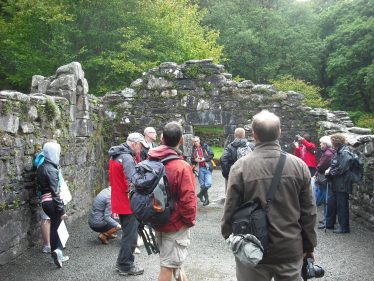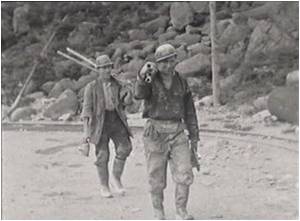Peopling the Landscape



“The Round Tower first takes the eye, and as we advance the several points of interest, one after another, come into sight. It is impossible to imagine aught in Nature more awefully grand than the lake
“Whose gloomy shore
Skylarks never warbles o’er”
in the midst of the mountains that surround it on all sides save the east”.
So wrote Mr. and Mrs. Hall, the intrepid 19th century travel writers, of their visit to Glendalough in 1842, while quoting the words of the Irish bard, Thomas Moore. The Round Tower, probably the greatest icon of Irish monasticism, is a tribute to the founder of the Monastic City, St. Kevin, as is the reference to the lack of music emanating from the skylarks which alludes to one of the many legends surrounding this great saint.
Glendalough, the valley of the two lakes, has long been associated with St. Kevin, the 6th century hermit who came to this valley seeking solace, peace and, through the natural beauty of the area, a closeness to God.
People came in pilgrimage to Glendalough seeking some of that solace that seems to emanate from this sacred landscape. By the 12th century, what is now known as the Monastic City, albeit in ruins today, had been developed to cater for the thousands who traversed St Kevin’s Way to follow in the footsteps of the holy man.
No doubt some of the descendants of those who had come as followers of St Kevin and had remained in the valley were among those who worked the mines in the three valleys of Glendasan, Glendalough and Glenmalure
Today, it is estimated that one million people visit Glendalough to see and experience the sense of tranquillity, peace and spirituality that is so evident there. Very few of these visitors realise that there is another layer to the history of this valley and that these valleys represent sites of major industrial heritage that spanned two centuries. The signs are still there for all to see – though perhaps not recognise or understand – the spoil heaps and the ruined buildings.
But that is why the Glens of Lead are here – to help visitors to our valleys in person or virtually – to learn about the history and heritage of these hills and valleys and to understand the landscape. Most importantly, Glens of Lead wish to ‘people the landscape’, to bring to life the lives of the many thousands of men and their families who worked and lived in these valleys to extract lead and zinc for the industrial revolution and development of our world from the late 18th century to the middle of the 20th century.
We wish to acknowledge and remember those people – because they had made us the people we are today.




No Comments
Add a comment about this page